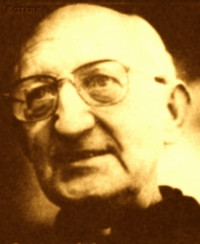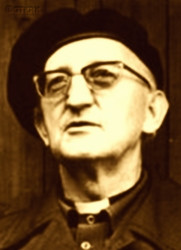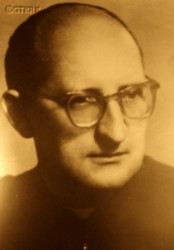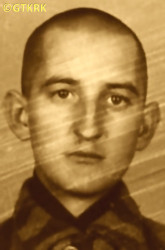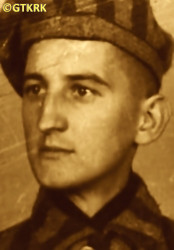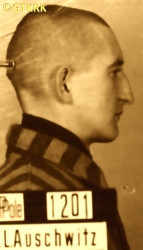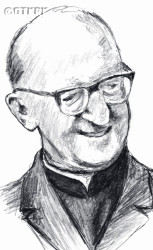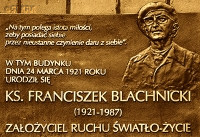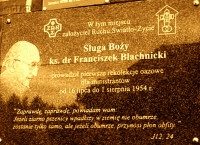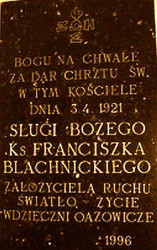Roman Catholic
St Sigismund parish
05-507 Słomczyn
85 Wiślana Str.
Konstancin deanery
Warsaw archdiocese, Poland
full list:
displayClick to display full list

searchClick to search full list by categories
wyświetlKliknij by wyświetlić pełną listę po polsku

szukajKliknij by przeszukać listę wg kategorii po polsku

Martyrology of the clergy — Poland
XX century (1914 – 1989)
personal data
religious status
Servant of God
surname
BLACHNICKI
forename(s)
Francis Charles (pl. Franciszek Karol)
function
diocesan priest
creed
Latin (Roman Catholic) Church RCmore on
en.wikipedia.org
[access: 2014.09.21]
diocese / province
Katowice diocesemore on
en.wikipedia.org
[access: 2013.05.19]
academic distinctions
Doctor of Theology
date and place
of death
27.02.1987

Carlsbergtoday: Bad Dürkheim dist., Rhineland‐Palatinate state, Germany
more on
en.wikipedia.org
[access: 2022.08.05]
details of death
After German and Russian invasion of Poland in 09.1939 and start of the World War II commander of the resistance Armed Struggle Union ZWZ (part of Polish Clandestine State) in Tarnowskie Góry.
On 27.04.1940 arrested by the Germans.
On 25.06.1940 transported to the German concentration camp KL Auschwitz.
For 9 months detained in a penal company, including a month in a solitary cell — the bunker.
In 09.1941 taken to prison in Zabrze and then in Katowice.
On 30.03.1942 sentenced to death by guillotine.
On 17.06.1942 while on death row experienced conversion.
On 14.08.1942 had death sentence commuted to 10 years in prison.
Detained in various prisons and concentration camps in Rawicz, Börgermoor, Zwickau and Lengenfeld (Flossenbürg).
On 17.04.1945 released.
In 03.1961 arrested by the Russian controlled Polish Commie‐Nazi UB, in connection with „sobriety crusade” („abstinence”) founded by him and shut down by Commie‐Nazis on 28.09.1960.
Held in Katowice prison, the same he was imprisoned in 1942.
After 4 months in prison sentenced to 10(13) months suspended sentence for „spreading false news about the persecution of the Church in Poland”.
In 1973, the Commie‐Nazi authorities refused to approve his habilitation thesis, previously recognized by the Academic Senate of the Catholic University KUL of Lublin.
After declaration of the martial law by commi–nazis in 1981, could not return to the country being sought for by an arrest warrant.
Constantly slandered by the Commie‐Nazi authorities of the prl (People's Republic of Poland) and their agents, also outside the borders of prl (many operational activities were conducted against him, including: under code name „Baxis”, together with the criminal East German Stasi organization).
Resided in Carlsberg. There was poisoned by agents of Commie‐Nazi prl.
On 14.02.2023, the Prosecutor General of the Republic of Poland announced publicly that the investigation conducted by the Institute of National Remembrance IPN proved conclusively that was murdered „by administering deadly toxic substances”.
prisoner camp's numbers
1201Click to display source page (KL AuschwitzClick to display the description)
cause of death
poisoning
perpetrators
Russians / Poles
sites and events
Martial law of 1981Click to display the description, KL FlossenbürgClick to display the description, KL Zwickau / Schloß OstersteinClick to display the description, RawiczClick to display the description, Katowice (prison)Click to display the description, KL AuschwitzClick to display the description, Regierungsbezirk KattowitzClick to display the description, Ribbentrop‐MolotovClick to display the description, Pius XI's encyclicalsClick to display the description
date and place
of birth
24.03.1921

Rybniktoday: Rybnik city pov., Silesia voiv., Poland
more on
en.wikipedia.org
[access: 2021.08.12]
parents
BLACHNICKI Joseph
🞲 ?, ? — 🕆 ?, ?

MÜLLER Mary
🞲 ?, ? — 🕆 ?, ?
presbyter (holy orders)
ordination
15.06.1950

Katowicetoday: Katowice city pov., Silesia voiv., Poland
more on
en.wikipedia.org
[access: 2021.08.12]
St Peter and St Paul the Apostles RC cathedral churchmore on
pl.wikipedia.org
[access: 2016.04.23]
positions held
1982 – 1987
resident — Carlsbergtoday: Bad Dürkheim dist., Rhineland‐Palatinate state, Germany
more on
en.wikipedia.org
[access: 2022.08.05] ⋄ Light–Life International Center for Evangelization and Christian Service for the Liberation of Nations „Marianum” — also: founder (25.03.1982), in former Polish Youth House „Marianum”
founder — Light–Life Movement
priest — national, Liturgical Service
till c. 1976
lecturer — Lublintoday: Lublin city pov., Lublin voiv., Poland
more on
en.wikipedia.org
[access: 2021.08.20] ⋄ Pastoral Theology Institute, Department of Theology, Catholic University of Lublin KUL [i.e. Catholic University of Lublin KUL (since 1928) / clandestine Catholic University of Lublin KUL (1939‐1944) / University of Lublin (1918‐1928)] — in 1972‐1976 led commissioned classes
1971 – 1973
postdoctoral degree (habilitation) — Lublintoday: Lublin city pov., Lublin voiv., Poland
more on
en.wikipedia.org
[access: 2021.08.20] ⋄ Pastoral Theology Section, Department of Theology, Catholic University of Lublin KUL [i.e. Catholic University of Lublin KUL (since 1928) / clandestine Catholic University of Lublin KUL (1939‐1944) / University of Lublin (1918‐1928)] — habilitation thesis „Ecclesiological deduction of pastoral theology” (approved by the Academic Senate of the Catholic University of Lublin on 23.06.1973, rejected by the Commie–Nazi authorities of prl)
1966 – 1967
deputy director — Lublintoday: Lublin city pov., Lublin voiv., Poland
more on
en.wikipedia.org
[access: 2021.08.20] ⋄ Student Priests' Halls of Residence, Catholic University of Lublin KUL [i.e. Catholic University of Lublin KUL (since 1928) / clandestine Catholic University of Lublin KUL (1939‐1944) / University of Lublin (1918‐1928)]
from 1964
assistant — Lublintoday: Lublin city pov., Lublin voiv., Poland
more on
en.wikipedia.org
[access: 2021.08.20] ⋄ Pastoral Theology Section, Department of Theology, Catholic University of Lublin KUL [i.e. Catholic University of Lublin KUL (since 1928) / clandestine Catholic University of Lublin KUL (1939‐1944) / University of Lublin (1918‐1928)]
1963 – 1965
PhD student — Lublintoday: Lublin city pov., Lublin voiv., Poland
more on
en.wikipedia.org
[access: 2021.08.20] ⋄ Pastoral Theology Section, Department of Theology, Catholic University of Lublin KUL [i.e. Catholic University of Lublin KUL (since 1928) / clandestine Catholic University of Lublin KUL (1939‐1944) / University of Lublin (1918‐1928)] — PhD thesis „The salvific mediation of the Church as defined by Francis Xavier Arnold. The problem of the principle of formal pastoral theology” (defense on 19.06.1965)
1961 – 1963
student — Lublintoday: Lublin city pov., Lublin voiv., Poland
more on
en.wikipedia.org
[access: 2021.08.20] ⋄ Pastoral Theology Section, Department of Theology, Catholic University of Lublin KUL [i.e. Catholic University of Lublin KUL (since 1928) / clandestine Catholic University of Lublin KUL (1939‐1944) / University of Lublin (1918‐1928)] — Bachelor's thesis „The experiential and educational method of children's closed retreats. Pedagogical and pastoral study” (defense on 09.05.1963)
1957 – 1960
organizer — Katowicetoday: Katowice city pov., Silesia voiv., Poland
more on
en.wikipedia.org
[access: 2021.08.12] ⋄ Crusade of Temperance, Pastoral Office, Diocesan Curia
1956 – 1961
employee — Katowicetoday: Katowice city pov., Silesia voiv., Poland
more on
en.wikipedia.org
[access: 2021.08.12] ⋄ Diocesan Curia
1956 – 1961
editor — magazine, „Sunday Guest”
vicar — Bieruń Starytoday: district of Bieruń, Bieruń urban gm., Bieruń‐Lędziny pov., Silesia voiv., Poland
more on
en.wikipedia.org
[access: 2020.11.05] ⋄ St Bartholomew the Apostle RC parish
vicar — Cieszyntoday: Cieszyn gm., Cieszyn pov., Silesia voiv., Poland
more on
en.wikipedia.org
[access: 2021.12.18] ⋄ St Mary Magdalene RC parish ⋄ Cieszyntoday: Cieszyn gm., Cieszyn pov., Silesia voiv., Poland
more on
en.wikipedia.org
[access: 2021.12.18] RC deanery
vicar — Rydułtowytoday: Rydułtowy urban gm., Wodzisław Śląski pov., Silesia voiv., Poland
more on
en.wikipedia.org
[access: 2021.04.02] ⋄ St George the Martyr RC parish
vicar — Łaziska Górnetoday: Łaziska Górne urban gm., Mikołów pov., Silesia voiv., Poland
more on
en.wikipedia.org
[access: 2021.12.18] ⋄ Our Lady the Queen of the Rosary RC parish
vicar — Tychytoday: Tychy city pov., Silesia voiv., Poland
more on
en.wikipedia.org
[access: 2022.01.28] ⋄ St Mary Magdalene RC parish
1945 – 1950
student — Krakówtoday: Kraków city pov., Lesser Poland voiv., Poland
more on
en.wikipedia.org
[access: 2021.06.07] ⋄ Department of Theology, Jagiellonian University UJ
1945 – 1950
student — Krakówtoday: Kraków city pov., Lesser Poland voiv., Poland
more on
en.wikipedia.org
[access: 2021.06.07] ⋄ philosophy and theology, Silesian Theological Seminary ⋄ Katowice RC diocese
others related
in death
KIJClick to display biography Anthony, KOWALCZYKClick to display biography Stanislav (Fr Honoré), NIEDZIELAKClick to display biography Steven, PALIMĄKAClick to display biography Stanislav, POPIEŁUSZKOClick to display biography George Alexander, SUCHOWOLECClick to display biography Stanislav, ZYCHClick to display biography Silvester
sites and events
descriptions
Martial law of 1981: Martial law declared on 13.12.1981 by Russian controlled Polish Commie‐Nazi party and army of the Russian republic prl — under the leadership of an organized crime group led by General Wojciech Jaruzelski — aimed to liquidate the independent, sels‐governing trade union NSZZ «Solidarity». During c. 8 years of martial law regulations Security Police SB, Polish Commie‐Nazi unit of Russian NKVD, murdered over 100 activists of «Solidarity». At least six priests were also killed in circumstances never fully explained. (more on: en.wikipedia.orgClick to attempt to display webpage
[access: 2015.03.01])
KL Flossenbürg: German Germ. Konzentrationslager (Eng. concentration camp) KL, founded in 05.1938, where a total of approx. 96,000 prisoners were held captive. In 1942 it became the „mother camp” for many external commandos and sub‐camps whose prisoners worked as slaves for the needs of the German arms industry. On 09.04.1945 Germans executed in the camp several people related to 20.07.1944 assassination plot on Hitler, including Wilhelm Canaris, Hans Oster and Dietrich Bonhoeffer. On 20.04.1945, facing the approach of the Allied troops, about 22,000 prisoners were marched out in the so‐called „Death March” to KL Dachau. Over 7,000 perished along the way. The camp was liberated on 23.04.1945 by American troops. In total, 30,000‐77,000 prisoners died in the camp, including up to 17,000 Poles. (more on: en.wikipedia.orgClick to attempt to display webpage
[access: 2021.05.20])
KL Zwickau / Schloß Osterstein: A heavy German prison in Zwickau in Saxony, founded in 1770‐1775 at the Schloß Osterstein castle. In the XIX c., among its detainees were Karl May, August Bebel, Rosa Luxemburg. During World War II, prob. had the status of Germ. Konzentrationslager (Eng. concentration camp) KL Zwickau / Schloß Osterstein and political prisoners were held there under an extralegal system, euphemistically known as the German Schutzhaft (Eng. protective custody). Prisoners, living in overcrowded cells, slave laboured in the city receiving starvation rations. (more on: en.wikipedia.orgClick to attempt to display webpage
[access: 2010.08.11])
Rawicz: Prison, founded in 1819‐1821, in place of the Franciscan Friars Minor's monastery, which was liquidated by the Prussian occupation authorities. During the World War II, during the German occupation of 1939‐1945, the German Germ. Zuchthaus (Eng. heavy prison), intended for men sentenced to long‐term imprisonment and penal camp sentences, levied mainly by the Germ. Warthegau (Eng. Wartha region) occupation courts. A large part of the prisoners were next transported from there to German concentration camps. After the end of the military operations of World War II, the prison was managed by the Commie‐Nazi authorities of the Russian prl republic. Many activists of the Polish clandestine independence underground were detained there, including soldiers of the Home Army AK. Political prisoners were finally released in 1956. (more on: pl.wikipedia.orgClick to attempt to display webpage
[access: 2013.08.17])
Katowice (prison): Detention centre run by Germans and later, in 1945, took over by the Commie‐Nazis.
KL Auschwitz: German Germ. Konzentrationslager (Eng. concentration camp) KL and Germ. Vernichtungslager (Eng. extermination camp) VL Auschwitz was set up by Germans around 27.01.1940 n. Oświęcim, on the German territory (initially in Germ. Provinz Schlesien — Silesia Province; and from 1941 Germ. Provinz Oberschlesien — Upper Silesia Province). Initially mainly Poles were interned. From 1942 it became the centre for holocaust of European Jews. Part of the KL Auschwitz concentration camps’ complex was Germ. Vernichtungslager (Eng. extermination camp) VL Auschwitz II Birkenau, located not far away from the main camp. There Germans murdered likely in excess of million people, mainly Jews, in gas chambers. In KL Auschwitz alone, the Germans murdered c. 30,000 prisoners by lethal injection. Until 1941, people were killed by intravenous injections of concentrated hydrogen peroxide, ether, hydrogen peroxide, or gasoline. Later, an intracardiac injection was used — with a needle about 10 cm long — of 10‐15 ml of a 30% solution of phenol C6H5OH (acquired from the German concern IG Farben, or more precisely from its subsidiary Bayer, and still used by Bayer AG, among others, for the production of aspirin), which killed within 15 seconds. Altogether In excess of 400 priests and religious went through the KL Auschwitz, c. 40% of which were murdered (mainly Poles). (more on: en.auschwitz.org.plClick to attempt to display webpage
[access: 2012.11.23], www.meczennicy.pelplin.plClick to attempt to display webpage
[access: 2013.07.06])
Regierungsbezirk Kattowitz: After the Polish defeat in the 09.1939 campaign, which was the result of the Ribbentrop‐Molotov Pact and constituted the first stage of World War II, and the beginning of German occupation in part of Poland (in the other, eastern part of Poland, the Russian occupation began), the Germans divided the occupied Polish territory into five main regions (and a few smaller). The largest one was transformed into Germ. Generalgouvernement (Eng. General Governorate), intended exclusively for Poles and Jews and constituting part of the so‐called Germ. Großdeutschland (Eng. Greater Germany). From two separate new provinces were created. The two remaining were incorporated into existing German provinces. One of those was Polish Upper Silesia, which on 08.09.1939, by decree of the German leader Adolf Hitler (formally came into force on 26.10.1939), was incorporated into Germany as the Germ. Regierungsbezirk Kattowitz (Eng. Katowice Regency) and became part of the Germ. Provinz Schlesien (Eng. Province of Silesia) based in Wrocław. On 01.04.1940, the Germ. Regierungsbezirk Kattowitz was enlarged by several pre‐war German counties, and on 18.01.1941, a new German province was created, the Germ. Provinz Oberschlesien (Eng. Province of Upper Silesia), which, apart from the Germ. Regierungsbezirk Kattowitz, also included the Opole region. From 26.10.1939, when the regency was established, the law of the German state was in force there, the same as in Berlin. The main axis of the policy of the new regency, the territory of which the Germans recognized as the Germ. „Ursprünglich Deutsche” (Eng. „natively German”), despite the fact only 6% of its pre–war Polish part were Germans, was Germ. „Entpolonisierung” (Eng. „Depolonisation”), i.e. forced Germanization. The main mechanism was the introduction of the Germ. Deutsche Volksliste DVL, a German nationality list that was supposed to specify the national affiliation of the inhabitants of the region. The largest group marked in the compulsory registrations was Group 3, people who identified themselves as „Silesians” (in 1943 about 41%), and people remaining outside the DVL (about 36%). The latter group was intended to be deported to the Germ. Generalgouvernement (which did not happen en masse because German industry needed slave labor). Group 3, considered by the Germans as capable of Germanization, was subject to certain legal restrictions, and was subject to, among others, to conscription into the German Wehrmacht army. Children could only learn in German. A policy of terror was pursued against the Polish population. There was a special police court, controlled by the Germ. Geheime Staatspolizei (Eng. Secret State Police), i.e. the Gestapo, before which c. 4,000‐5,000 people were detained. For the years 1942‐1945 over 2,000 of them were verified, of which 1,890 were sentenced to death, including 286 in public executions. Thousands of people were murdered during the so‐called «Intelligenzaktion Schlesien», including 300‐650 Polish teachers and c. 61 Polish Catholic priests. The regency hosted a German concentration and extermination camp KL Auschwitz, where the Germans imprisoned c. 1,100,000 Jews (murdering c.1,000,000, i.e. c. 90% of them) and c. 140,000 Poles (murdering c. 70,000, i.e. c. 50% of them). After the end of hostilities of World War II, the overseer of this province, the Germ. Reichsstatthalter (Eng. Reich Governor) and the Germ. Gauleiter (Eng. district head) of the German National Socialist Party, Fritz Brecht, committed suicide. (more on: en.wikipedia.orgClick to attempt to display webpage
[access: 2024.06.24])
Ribbentrop‐Molotov: Genocidal Russian‐German alliance pact between Russian leader Joseph Stalin and German leader Adolf Hitler signed on 23.08.1939 in Moscow by respective foreign ministers, Mr. Vyacheslav Molotov for Russia and Joachim von Ribbentrop for Germany. The pact sanctioned and was the direct cause of joint Russian and German invasion of Poland and the outbreak of the World War II in 09.1939. In a political sense, the pact was an attempt to restore the status quo ante before 1914, with one exception, namely the „commercial” exchange of the so‐called „Kingdom of Poland”, which in 1914 was part of the Russian Empire, fore Eastern Galicia (today's western Ukraine), in 1914 belonging to the Austro‐Hungarian Empire. Galicia, including Lviv, was to be taken over by the Russians, the „Kingdom of Poland” — under the name of the General Governorate — Germany. The resultant „war was one of the greatest calamities and dramas of humanity in history, for two atheistic and anti‐Christian ideologies — national and international socialism — rejected God and His fifth Decalogue commandment: Thou shall not kill!” (Abp Stanislav Gądecki, 01.09.2019). The decisions taken — backed up by the betrayal of the formal allies of Poland, France and Germany, which on 12.09.1939, at a joint conference in Abbeville, decided not to provide aid to attacked Poland and not to take military action against Germany (a clear breach of treaty obligations with Poland) — were on 28.09.1939 slightly altered and made more precise when a treaty on „German‐Russian boundaries and friendship” was agreed by the same murderous signatories. One of its findings was establishment of spheres of influence in Central and Eastern Europe and in consequence IV partition of Poland. In one of its secret annexes agreed, that: „the Signatories will not tolerate on its respective territories any Polish propaganda that affects the territory of the other Side. On their respective territories they will suppress all such propaganda and inform each other of the measures taken to accomplish it”. The agreements resulted in a series of meeting between two genocidal organization representing both sides — German Gestapo and Russian NKVD when coordination of efforts to exterminate Polish intelligentsia and Polish leading classes (in Germany called «Intelligenzaktion», in Russia took the form of Katyń massacres) where discussed. Resulted in deaths of hundreds of thousands of Polish intelligentsia, including thousands of priests presented here, and tens of millions of ordinary people,. The results of this Russian‐German pact lasted till 1989 and are still in evidence even today. (more on: en.wikipedia.orgClick to attempt to display webpage
[access: 2015.09.30])
Pius XI's encyclicals: Facing the creation of two totalitarian systems in Europe, which seemed to compete with each other, though there were more similarities than contradictions between them, Pope Pius XI issued in 03.1937 (within 5 days) two encyclicals. In the „Mit brennender Sorge” (Eng. „With Burning Concern”) published on 14.03.1938, condemned the national socialism prevailing in Germany. The Pope wrote: „Whoever, following the old Germanic‐pre‐Christian beliefs, puts various impersonal fate in the place of a personal God, denies the wisdom of God and Providence […], whoever exalts earthly values: race or nation, or state, or state system, representatives of state power or other fundamental values of human society, […] and makes them the highest standard of all values, including religious ones, and idolizes them, this one […] is far from true faith in God and from a worldview corresponding to such faith”. On 19.03.1937, published „Divini Redemptoris” (Eng. „Divine Redeemer”), in which criticized Russian communism, dialectical materialism and the class struggle theory. The Pope wrote: „Communism deprives man of freedom, and therefore the spiritual basis of all life norms. It deprives the human person of all his dignity and any moral support with which he could resist the onslaught of blind passions […] This is the new gospel that Bolshevik and godless communism preaches as a message of salvation and redemption of humanity”… Pius XI demanded that the established human law be subjected to the natural law of God , recommended the implementation of the ideal of a Christian state and society, and called on Catholics to resist. Two years later, National Socialist Germany and Communist Russia came together and started World War II. (more on: www.vatican.vaClick to attempt to display webpage
[access: 2023.05.28], www.vatican.vaClick to attempt to display webpage
[access: 2023.05.28])
sources
personal:
pl.wikipedia.orgClick to attempt to display webpage
[access: 2015.03.01]
original images:
www.swietykrzyz.katowice.opoka.org.plClick to attempt to display webpage
[access: 2015.03.01], blachnicki.oaza.plClick to attempt to display webpage
[access: 2015.03.01], de.popotam.ayz.plClick to attempt to display webpage
[access: 2015.03.01], slideplayer.plClick to attempt to display webpage
[access: 2015.03.01], www.auschwitz.orgClick to attempt to display webpage
[access: 2018.11.18], www.auschwitz.orgClick to attempt to display webpage
[access: 2018.11.18], docplayer.plClick to attempt to display webpage
[access: 2018.02.15], www.encyklo.plClick to attempt to display webpage
[access: 2021.12.19], photo.bikestats.euClick to attempt to display webpage
[access: 2015.03.01], www.kik.katowice.opoka.org.plClick to attempt to display webpage
[access: 2015.03.01]
LETTER to CUSTODIAN/ADMINISTRATOR
If you have an Email client on your communicator/computer — such as Mozilla Thunderbird, Windows Mail or Microsoft Outlook, described at WikipediaPatrz:
en.wikipedia.org, among others — try the link below, please:
LETTER to CUSTODIAN/ADMINISTRATORClick and try to call your own Email client
If however you do not run such a client or the above link is not active please send an email to the Custodian/Administrator using your account — in your customary email/correspondence engine — at the following address:

giving the following as the subject:
MARTYROLOGY: BLACHNICKI Francis Charles
To return to the biography press below:
 Click to return to biography
Click to return to biography








